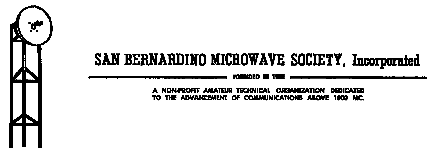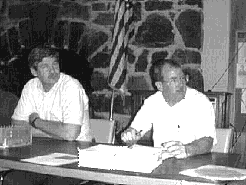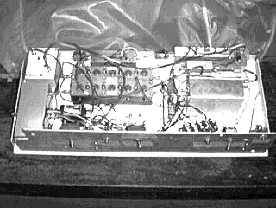

President: Doug Millar, K6JEY 2791 Cedar Ave Long Beach, CA 90806 562-424-3737 dougnhelen@moonlink.net
Vice President: Dick Bremer, WB6DNX 1664 Holly St. Brea, CA 92621 714-529-2800 rabremer@juno.com
Recording Sec:Mel Swanberg, WA6JBD 231 E Alessandro Blvd Riverside, CA 92508 909-369-6515 swanberg@pe.net
Corresponding Sec: Kurt Geitner, K6RRA 213 Main St. #5 Seal Beach, CA 90740 310-718-4910 k6rra@gte.net
Treasurer: Dick Kolbly, K6HIJ 26335 Community Barstow, CA 92311 760-253-2477 rkolbly@compuserve.com
Editor: Bill Burns, WA6QYR 247 Rebel Rd Ridgecrest, CA 93555 760-375-8566 bburns@ridgecrest.ca.us
Webmaster Chip Angle, N6CA
ARRL Interface Frank Kelly, WB6CWN 1111 Rancho Conejo Blvd. #501 Newbury Park, CA 91320
805-499-8047 fk@event1.com
FCC Interface Dave Laag, K6OW 11614 Indian St. Moreno Valley, CA 92557 909-924-1517
W6IFE License Trustee Ed Munn, W6OYJ 6255 Radcliffe Dr. San Diego, CA 92122 619-453-4563
edmunn@compuserve.com
The 3 May 2001 meeting of the SBMS will have Bill, WA6QYR talk about the 2 GHz transverter he build from the excess 2 GHz band parts that Dick, WB6DNX collected in 1998 and passed on to the membership. More on those hardware items is found in this newsletter. The SBMS meets at the American Legion Hall 1024 Main Street (south of the 91 freeway) in Corona, CA at 1900 hours local time on the first Thursday of each month. Check out the SBMS web site at http://www.ham-radio.com/sbms/.
Last meeting Mel, WA6JBD talked about the radio path he worked on and had data sheets to show what happened. A write-up is found elsewhere in this edition. Thanks Mel for a good talk. Welcome to visitor Hon Chu, KQ6EE of Arcadia. Welcome to new member Randy Fear, KC6JTN who has 10 GHz hardware on the air. 20 people present.
Elections of April. Elected were President, Doug, K6JEY; VP Dick, WB6DNX; Recording Sec; Mel Swanberg, WA6JBD; Corresponding Sec; Kurt Geitner, K6RRA; Treasurer; Dick Kolbly, K6HIJ; and Editor; Bill Burns, WA6QYR. Congratulations to the re-elected crew of 2000!
Prez Sez-Well, it's about time to "shoot the engineer" again. Just a reminder for your projects:
1. Do the antennas last and the phase locked loop first. Horns will get you on the air, are simple to use and QUICK. DC wiring and packaging take much more time than one would assume.
2. Don't freeze your project on some detail. Get it working and then pretty it up. Work around or simplify the things that are freezing you up.
3. Don't work alone. We are a club and there are plenty of people out there willing to help. Call me or someone else to help you out of a problem or for testing. (See above for phone numbers and email. Ed)
4. The contest is in Aug. and Sept.- however the Get Ready session is in late July. Plan to be ready by the first of July.
5. If you have all your stuff neatly stored since last year and you are sure no one and nothing has touched any part of it, now is the time to pull it out and see what the Menehunies, Nunchkins, or Nissen have been doing all these months to your rig(s). It is also the time to put in those extra touches you didn't have time for last year. I know you don't have time to do it, but it doesn't work well as an excuse when you are on top of Frazer, Heaps or even Signal Hill without a soldering iron or signal generator.
GET IN CONTACT-So that we can get an idea of who is doing what, and pair people up if they like. Please email me if you are working on one of the following stations, what stage you are in, and let me know if you want to get in contact with other people working on the same frequencies. 24 GHz wide band
24 GHz narrow band, 47 GHz wide or narrow. Higher? If you are working on another mode or band and want to find someone to work with, let me know also. You can also put a blurb in the newsletter via Bill, WA6QYR, to let people know what you are doing.
Here's an example: K6JEY, 24 GHz wideband- operational &endash;tested, 24 GHz narrowband- all the parts and LO. Need to wire DC up and test it, 47 GHz antenna, front end ok. multiplier ok, but need to fix LO and wire up and test. Looking for partner/encouragement. &endash; Doug, K6JEY
Scheduling
7 June Program GPS frequency ref and things.
9 June ARRL VHF QSO Contest
23 June Field Day
5 July Program TBD
28 July Antenna/ rig test day in an LA area park following the TRW swap meet.
2 August Program TBD
4 August UHF Contest
18-19 August ARRL 10 GHz and Up Cumulative contest 1st half
6 September Program TBD
8 September ARRL September VHF Contest
15-16 September ARRL 10 GHz and Up Cumulative contest 2nd half
Wants and gots
Wanted- Schematic or manual on HP101 1 MHz/ 10 MHz frequency Standard, Dick, WB6DNX 714-529-2800.
Want- manual for HP 8551A Spectrum Analyzer RF unit Kurt K6RRA.
Want Manual and/or schematic for Volling R-388/UUR (51J2?)
Activity reported at the 5 April SBMS meeting: Dick, WB6DNX was working with the filters on the newest Qualcomm 10 GHz rig, Larry, K6HLH built a box for tower mount preamps; Hon Chu, KQ6EE is visiting; George, K6MBL had his 1956 car call license plates to show; Dick, K6HIJ got some test equipment operating; Kurt, K6RRA made some 10 GHz contacts; Mel, WA6JBD cleaned his garage and carried in some 2 GHz system parts to the meeting and worked on his tech talk; Jeff, KN6VR got some preamps working; Bob, W6SYA reassembled his 10 GHz rig; Ken, WB6DTA put up some antennas for 900 MHz , 2.3, and 3 GHz; Ed, K6ODV changed out some coax going to his tower; Bill, WA6QYR worked on his 2 GHz transverter; Chuck, WA6EXV did some 24 GHz testing, built a slot antenna for the 2 GHz beacon, and is testing the beacon; Frank, WB6CWN is planning some summer outings;
The Mt. Vaca (CM88WJ) 10 GHz Beacon operating on 10,368.325 MHz was removed from the site yesterday 3/29/01 for maintenance and upgrades. It is expected to be off the air temporarily for several months. Jim...W6ASL
From the ARRL: We do have available the 2000 Microwave Update, order #MU00, $20.00 plus
$5.00 for shipping. You can order with your credit card through email, fax 860-594-0303, call toll free 888-277-5289 or through our web page at www.arrl.org. Any further questions, please let me know.
Sincerely, Lisa Tardette Pub. Sales - thanks Frank, WB6CWN
It appears that Qualcomm has discontinued manufacturing the 3036/3236 type PLL many of us are using for our microwave LOs (we still have many boards with the original ICs). Peregrine is offering drop in replacements with a 2.2 GHz and 3 GHz upper frequency limit and 30 milliamps current consumption at 3V. They claim lower phase noise, which I hope to checkout when I can get a device & mount it on a board. This might make a nice improvement all the way around if one is set up to replace such an IC.
Peregrines website for data sheets is at: http://www.peregrine-semi.com/prd_pll_pe3236.html
Richardson Electronics is the distributor at: http://www.peregrine-semi.com/prd_richardson.html
their website quotes the P3236 2 GHz version) at $25 and the P3336 (3 GHz version) at $27 in small quantities. - Kerry N6IZW &endash;

At the April meeting of the SBMS Mel, WA6JBD (shown on the right) spoke about his work at the Riverside County Communications group with a link within the county which had problems with signal drop out. The original analog 2 GHz link was installed in 1956 over the 16.4-mile path between Box Springs Mountain and Mount David. It never had problems with drop out. With technology upgrades over the years and the move to a digital system in 1990, the system continued to have more and more problems with increasing drop out time. This was a single dual direction path with hot back up hardware. The county then went to a space diversity system with two 8 ft antenna spaced some 60 ft apart up and down on the tower at each end of the path later in 1990. Problems still persisted. Path prediction software indicated no Fresnel interference. In 1993 they moved to 15 ft antennas with an up tilt to attempt to reduce any ground reflections. That solved most of the problems. With the 1997 FCC changes in frequency allocations, the new PCS owners of the 2 GHz band purchased 6 GHz hardware for the problem link. The "new" system has 30 ft space diversity with 8 ft antennas, plus angle diversity, antenna feeds that allow squinting of the beam with sum and difference pattern selections, and a transmit power AGC. Since 1998 the link hasn't lost signal. It was suspected that there was a combination of long delayed ground bounce interference and a sky path that would some time induce additional reflections. Now 911 and other county communications on the network are stable.
Some notes from testing done by Bill, WA6QYR and Chuck, WA6EXV on Farinon/ Harris surplus 2 GHz parts in 1998 that were used in Bill's 2 GHz transverter shown at the April meeting and the talk to be given at the May meeting:
2 GHz LNC image reject mixer 076-106988 modified by WA6EXV- +10 dBm LO required at 2160 MHz, 28 dB gain, 65 dB image rejection at 144 MHz.
2 GHz LNA 076-106449 SD-106448 has around 2.2 to 2.6 dB NF, 25 dB gain at 2.3 GHz. +12v at 70 ma and &endash;20v at 14 ma.
2 GHz linear power amps SD-106405 &endash; only the front half of the unit works at 2.3 GHz. Cut off the back half and add a SMA. Generally the front half has about 20 dB gain with max +19 dBm output. +12 v input at about 40 ma.
RF Hybrid (splitter) SD-105117 just a 3 dB resistive divider.
KDI Mixer 64537 just a mixer needing about 7 dBm LO.
LO "microwave brick"- need to change the crystal to 108 MHz for 2160 MHz LO. It has lots of 108 MHz crystal signal in the output so need to filter it out some where in your system. Schematics else where in this newsletter.
2 GHz Power amp 076-106935 is a one-watt device, but I wasn't able to get enough drive to make it play properly. &endash;20v at 1.6 amp. Some where in the 10 dB gain level.
Dual 5-cavity filter SD-105370- need to remove 0.050 inches of material from each post to tune into 2.3 GHz. Has about 20 MHz bandwidth with lots of rejection out side the pass band. About 1-2 dB insertion loss. Chuck, WA6EXV cut all the filters that were available and he and Bill retuned them into the 2.3 GHz band before they were passed out at the SBMS meetings.
Single 5-cavity filter SD-106312, same as above.

Bill, WA6QYR's 2 GHz transverter made from old Farinon 2 GHz parts as shown at the April and May SBMS meetings. San Bernardino Microwave Society is a technical amateur radio club affiliated with the ARRL having a membership of over 90 amateurs from Hawaii and Alaska to the east coast. Dues are $15 per year which includes a badge and monthly newsletter. Your mail label indicates your call followed by when your dues are due. Dues can be sent to the treasurer as listed under the banner on the front page. If you have material you would like in the newsletter please send it to Bill WA6QYR at 247 Rebel Road Ridgecrest, CA 93555, bburns@ridgecrest.ca.us, or phone 760-375-8566. The newsletter is generated about the 15th of the month and put into the mail at least the week prior to the meeting. This is your newsletter. SBMS Newsletter material can be copied as long as SBMS is identified as source.
San Bernardino Microwave Society newsletter
247 Rebel Road
Ridgecrest, CA
93555
USA